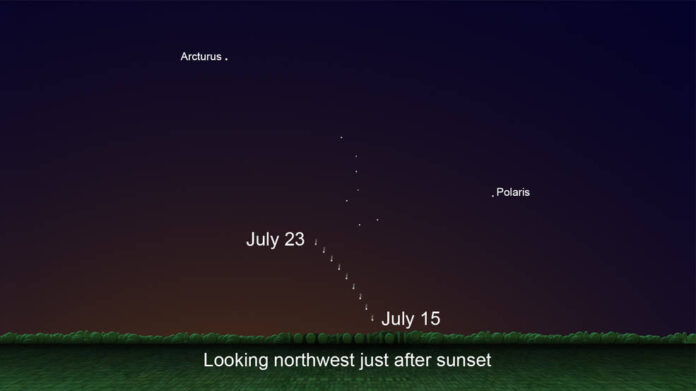Folks around the country are posting images of Comet NEOWISE on social media that are gorgeous. I sure do miss my personal photographer. I would look and he would take the photos. Thanks to huge shopping areas and fueling centers that have lighting that overpowers the night, street lights and home decorative lighting across the street, I don’t have dark skies near my home these days to see stars with the unaided eye.
And I don’t feel disposed to roam dark roads without him, so I am stuck with what other folks share from their non-light polluted neighborhoods in other parts of the country.
If you live out in a darker part of the county make an opportunity to go out and look in the NNW within an hour and a half of twilight. Space.com recommends using binoculars and be far away from urban areas. The moon will be waning and not an issue. As we move into August the comet will be higher in the sky, although less bright.
NEOWISE is a NASA space telescope, Near-Earth Object Wide-Field Infrared Survey Explorer. Using infrared imaging techniques allows objects to be located in our universe that otherwise might not be observed with optical tools.
Comets are intriguing and have always made humans pay attention. They were believed to be portents of either great success or great disaster. Given today’s conditions around the globe, that is something to pause and ponder over.
Eventually there may be a new meteor shower for earthlings to enjoy as this comet leaves debris behind in its orbital path that our home planet will someday pass through and you can tell your descendants about the year of the COMET NEOWISE and what was happening in your life at the time.
August 11-12 will be the peak of the Perseid meteor shower this year. Perhaps we will be able to gather in small groups to view this annual event at a dark site and contemplate what was going on in history when Comet Swift-Tuttle last passed through Earth’s orbit in 1862 on its 133 year long orbital path. The shower is visible from mid-July to mid-August, usually visible between midnight and dawn. Stray meteors can often be seen any time of the year, but showers occur during specific dates that correspond to more than a few meteoroids – sometimes up to 60 being seen per hour. Showers are named for the constellation that seems to be the source of the “falling stars” that rain from the sky. Perseus, located in the NE, is the constellation for the Perseids radiant.
If you are curious about what comets actually are you may want to check out the Stardust mission to a comet site on <https://stardust.jpl.nasa.gov/home/index.html.> This highly successful mission returned samples of pristine Comet Wild2 in January 2006 in a capsule filled with pockets of a unique substance called Aerogel®. The samples were shared out among scientists who analyzed them and reported the often-surprising results to the world.
These “hairy” or “fuzzy stars” are a field of study unto themselves and many nonprofessionals were involved in the research as they used the Stardust@home site to examine sample segments looking for miniscule particles trapped in the Aerogel®.
Until next week, go out and look up.




